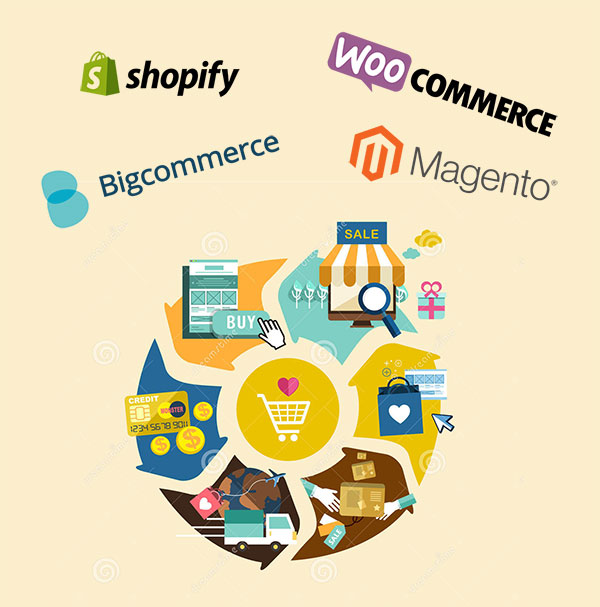
The pros and cons of 4 top e-commerce platforms revealed
For someone who’s just coming in, all e-commerce platforms might seem similar minus a few differences. While it might be true in some cases, some e-commerce platforms – Shopify, Woocommerce, BigCommerce and Magento vary greatly from each other and might be more suited for one type of person or business over the other. This unbiased post goes through the differences.
Maybe you have more technical knowledge than most and need something that will allow for more control over convenience. Others might need a platform that will guide them by the hand and do practically everything for them. There are also tons of other features to look for depending on your level of expertise, budget, needs, and expectations. Let’s take a look at some of the top e-commerce platforms at the moment, and whether they would be a good choice for you.
Shopify
Let’s start with the biggest out of the bunch. Shopify has taken the world of e-commerce by storm and has become the most popular stand-alone platform on the market. As a matter of fact, there are no other platforms of its kind that come even close, and it’s easy to understand why.
Shopify is one of the best platforms for beginners. There is little coding experience to get started, and their customer service is stellar. The packages are also very affordable, which allows people with a small budget to compete and have a professional, beautiful, and safe site without breaking the bank. Prices start at $29 and you get things like unlimited products and file storage, a blog module, and social media integration among other things.
Another great thing about Shopify is how easy it is to customize. It has over 100 great themes right out the box, and they’re already tailor-made for specific industries. It also has a very user-friendly and advanced analytics module that is easy to use and understand for anyone no matter their level of experience.
However, just like any platform, Shopify isn’t perfect. For one, while it has a great theme selection, not all of them are free. As a matter of fact, only 20 of them are, and others can cost you up to $180 a piece. Also, if you want to go Advanced, you have to be ready to pay $299 per month. This will give additional user access, more locations, and an advanced report builder among other things.
You also have to note that you will have to pay extra if you ever decide to use another payment system outside of Shopify payments. And, since you’ll be using liquid markup, you won’t have as much liberty with modifications, unless you’re ready to pay an additional fee.
For example; Building Insulation Solutions Shop uses shopify.
WooCommerce
WooCommerce and Shopify are often mentioned in the same breath, but they are very different platforms. For one, WooCommerce is an extension of WordPress, so you’ll need some experience with WordPress to understand it, and the learning curve might be steeper. WooCommerce is a better platform if you want more control, but don’t expect the same support.
However, if you want to have more control over your website and feel like you truly own it, then WooCommerce might be the choice for you. That also means that you have to find your own hosting solution and deal with your host’s own limitations. WooCommerce also comes with all the vulnerabilities you can expect from WordPress.
If you want a solid comparison between both services, PieSync has a nice comparison of Woocommerce against Shopify. On their site, you’ll learn more about what makes the difference between the two platforms and what you can expect. You’ll also learn which option would be best for someone who has a brick and mortar location versus someone who does their business 100% online. This is a great resource if you want to know which option would be the best for you if you’re a beginner vs someone who’s more experienced.
For example; Metal furniture store Anthology Five (this website was designed by our talented team at TLD) and Bits & PCs Refurbished PCs both use WooCommerce.
BigCommerce
BigCommerce is another big player in the game and has received some recognition from big players like Toyota and CamelBak. They claim that their merchants are growing at a faster rate than other platforms at 28%, which may or may not be because of their platform as they may simply have more established clients with bigger brands to begin with.
One of the biggest benefits of BigCommerce is how SEO friendly it is. So, if you have limited knowledge of SEO and a limited budget, then this could be a good option. They also offer good support and packages starting at $29.95 per month.
The issue here, however, is that it doesn’t come with free themes, so don’t expect to be able to pick it up right from the box. You should also note that BigCommerce puts annual limits on sales, so this is something you’ll have to be conscious about as far as scaling goes.
Examples of BigCommerce websites can be found here.
Magento
Magento is a major name in the industry, and has found popularity among both starters and big companies. As a matter of fact, many Fortune 500 have chosen Magento for their e-commerce websites, and it’s easy to see why.
The biggest reason is probably scalability. It’s also a very responsive platform. Magento comes with loads of pre-designed templates, but it also allows your team to come with custom themes or make tweaks and adjustments to the existing themes.
Magento is one of the most customizable options out there with it being open source. This also means, however, that the learning curve will be slightly steeper than with options like Shopify. Also, don’t expect to get the same level of service or get access to 24/7 help. But what it lacks in terms of support, it largely makes up for with its 100+ list of free templates. It’s also completely free to download and has no transaction fee.
If you were on the market for a solid e-commerce platform, these are some of the biggest names on the market. We suggest we give them all a look, check them out in detail and see which one works the best for you depending on your particular needs.
Further reading: “The ultimate review of Magento covers many of Magento’s features and pricing.
For example; Wooden Floors UK uses Magento.


Comments
Jack David
Nice Article